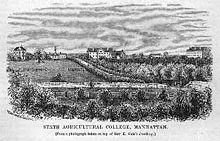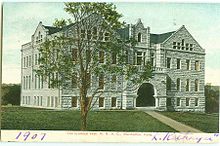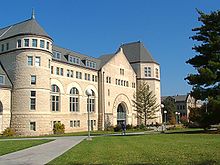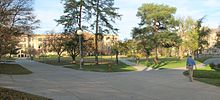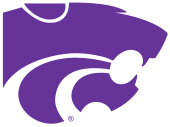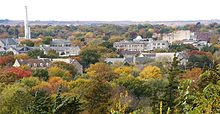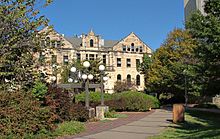- Kansas State University
-
Kansas State University 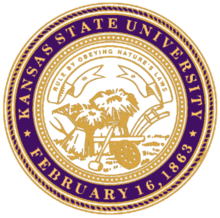
Motto Rule by Obeying Nature's Laws Established 1863 Type Public, State, Land-grant, University Endowment $277.6 million[1] President Kirk H. Schulz Academic staff 1,251[2] Students 23,863 (Fall 2011)[3] Undergraduates 19,205[4] Postgraduates 3,921[4] Location Manhattan, Kansas, U.S. Campus College town
Urban; 668 acres (main campus)Colors Royal purple Athletics NCAA Division I
Big 12 ConferenceSports 14 Varsity Teams Nickname Wildcats Affiliations APLU, ASAIHL Website www.k-state.edu Kansas State University, commonly shortened to K-State, is an institution of higher learning located in Manhattan, Kansas, in the United States. Kansas State is the oldest public university in the state of Kansas, and saw a record high enrollment of 23,588 students for the Fall 2011 semester.[3]
A branch campus is located in Salina, Kansas, housing the College of Technology and Aviation. Another branch campus, known as the Olathe Innovation Campus, is presently under construction in Olathe, Kansas. When completed, the Olathe facility will be the academic research presence within the Kansas Bioscience Park, and will research bioenergy, animal health, plant science and food safety and security.[5]
The university is classified as a research university with high research (RU/H) by the Carnegie Classification of Institutions of Higher Education.
Contents
History
Kansas State University, originally named Kansas State Agricultural College, was founded on February 16, 1863, during the American Civil War, as a land-grant institution under the Morrill Act.[6] The school was the first land-grant college created under the Morrill Act.[6][7] K-State is the fourth-oldest school in the Big 12 Conference and the oldest public university in the state of Kansas.
The effort to establish the school began in 1861, when Kansas was admitted to the United States. One of the new state legislature's top priorities involved establishing a state university. That year, the delegation from Manhattan introduced a bill to convert the old Blue Mont Central College (a private college incorporated in Manhattan in 1858) into the state university.[8] But the bill establishing the university in Manhattan was controversially vetoed by Governor Charles L. Robinson of Lawrence, and an attempt to override the veto in the Legislature failed by two votes.[9] In 1862, another bill to make Manhattan the site of the state university failed by one vote.[9] Finally, upon the third attempt on February 16, 1863, the state accepted Manhattan's offer to donate the Blue Mont College building and grounds and established the state's land-grant college at the site – the institution that would become Kansas State University.[9]
When the college opened for its first session on September 2, 1863, it became only the second public institution of higher learning to admit women and men equally in the United States. Enrollment for the first session totaled 52 students: 26 men and 26 women.[6] In 1874, the college became the first in the United States to offer printing courses, which led to journalism courses being launched in 1910; thus, today's A.Q. Miller School of Journalism & Mass Communications, though no longer teaching printing, has the nation's longest continuously offered curriculum in mass communication.[citation needed]
19th century
The early years of the institution witnessed debate over whether the college should provide a focused agricultural education or a full liberal arts education. During this era, the tenor of the school shifted with the tenure of university presidents. For example, President John A. Anderson (1873–1879) favored a limited education and President George T. Fairchild (1879–1897) favored a classic liberal education.[6][10] Fairchild was credited with saying, "Our college exists not so much to make men farmers as to make farmers men."[6]
During this era, in 1873, Kansas State also helped pioneer the academic teaching of home economics for women, becoming one of the first two colleges to offer the program of study.[11][12]
Recent history
The name of the school changed in 1931 to "Kansas State College of Agriculture and Applied Science". In 1959, the Kansas legislature changed the name again to "Kansas State University of Agriculture and Applied Science" to reflect a growing number of graduate programs, though, even in Kansas state legal matters, it is interchangeably referred to as Kansas State University.[13][14] Milton S. Eisenhower served as president of the university from 1943 to 1950, and Dr. James McCain succeeded him, serving from 1950 to 1975. Several buildings, including residence halls and a student union, were added to the campus in the 1950s. The 1960s witnessed demonstrations against the Vietnam War, though fewer than at other college campuses. Enrollment was relatively high through most of the 1970s, but the university endured a downward spiral from approximately 1976 to 1986, when enrollment decreased to 17,570 and a number of faculty resigned. In 1986, Jon Wefald assumed the presidency of Kansas State University. During his tenure, enrollment and donations increased.
On June 15, 2009, Kirk Schulz became the 13th president of Kansas State University.[15] In March 2010 he announced his K-State 2025 plan.[16] The initiative is designed to elevate K-State to a top 50 nationally recognized research university by 2025.
Historic buildings
See also: List of oldest buildings on Kansas colleges and universitiesThe university moved from the location of Blue Mont Central College to its present site in 1875.[6] The original site is now occupied by Central National Bank[disambiguation needed
 ] and Founders Hill Apartments. Holtz Hall, built in 1876, was the first new building erected after the move and is now the oldest free-standing building on campus.[6] The signature building at Kansas State University, Anderson Hall, developed in three stages between 1877 and 1885. Anderson Hall, now listed on the National Register of Historic Places, has housed the university's administrative offices for more than a century.
] and Founders Hill Apartments. Holtz Hall, built in 1876, was the first new building erected after the move and is now the oldest free-standing building on campus.[6] The signature building at Kansas State University, Anderson Hall, developed in three stages between 1877 and 1885. Anderson Hall, now listed on the National Register of Historic Places, has housed the university's administrative offices for more than a century.Academic profile
University rankings (overall) National Forbes[17] 153 U.S. News & World Report[18] 143 Washington Monthly[19] 189 Global ARWU[20] 301-400 Times[21] 351-400 Since 1986, Kansas State ranks first nationally among state universities in its total of Rhodes, Marshall, Truman, Goldwater, and Udall scholars with 124 recipients.[22]
Kansas State University has 65 academic departments in nine colleges: agriculture; Architecture, planning and design; arts and sciences; business administration; education; engineering; human ecology; technology and aviation; and veterinary medicine. The graduate school offers nearly 100 master's degree programs and nearly 50 doctoral programs.
In 1991, the former Kansas Technical Institute in Salina, Kansas was merged with Kansas State University by an act of the Kansas legislature. The College of Technology and Aviation is located at the Salina campus, and is commonly referred to as K-State Salina.
K-State is also known for several distinguished lecture series: Landon Lecture, Lou Douglas Lecture, Huck Boyd Lecture, and Dorothy L. Thompson Civil Rights Lectures. In recent years, the Landon Lecture Series has had high profile speakers, including President George W. Bush, President Bill Clinton, Former Mexican President Vicente Fox and Associate Justice Sonia Sotomayor.
K-State implemented an academic honor code in 1999.[23] When students are admitted, it is implied that they will adhere to the Honor Pledge: "On my honor, as a student, I have neither given nor received unauthorized aid on this academic work."
Research and cultural resources
Agriculture
The university has had a long-standing interest in agriculture, particularly native Great Plains plant and animal life. The Kansas State University Gardens is an on-campus horticulture display garden that serves as an educational resource and learning laboratory for K-State students and the public. The Konza Prairie is a native tallgrass prairie preserve located south of Manhattan, which is co-owned by The Nature Conservancy and Kansas State University and operated as a field research station by the department of biology. The university also owns an additional 18,000 acres (73 km2) in cities across the state that it operates as Agricultural Experiment Stations in research centers in Hays, Garden City, Colby, and Parsons.
Arts and culture
The university is home to several museums, including the Marianna Kistler Beach Museum of Art, the K-State Insect Zoo, the KSU Historic Costume and Textiles Museum, and the Chang, Chapman, and Kemper galleries which feature faculty and student artwork. The university also offers an annual cycle of performance art at McCain Auditorium, including concerts, plays and dance.[24]
The Biosciences
In 2006, K-State dedicated the Biosecurity Research Institute.[25] The BRI, in Pat Roberts Hall, is a safe and secure location in which scientists and their collaborators can study high-consequence pathogens. It was designed and constructed for biosafety level 3 (BSL-3) and biosafety level 3 agriculture (BSL-3Ag) research.[26]
The availability of the BRI was part of what attracted the National Bio and Agro-Defense Facility to K-State and Manhattan.[27] The NBAF will feature about 500,000 square feet (46,000 m2) of research and support space.[28] Construction of the NBAF will cost an estimated $650 million and should be complete by 2016.[29] It will stand just north of K-State's College of Veterinary Medicine and east of the BRI.[30]
Following the NBAF decision, leaders at two additional federal facilities announced they are coming to K-State. The Arthropod-Borne Animal Disease Research Unit, or ABADRU, specializes in animal and plant diseases transmitted by insects. The lab is relocating from Laramie, Wyo., to K-State in order to fully realize its research mandate.[31] The Center of Excellence for Emerging and Zoonotic Animal Diseases, or CEEZAD, will research foreign animal, zoonotic and newly discovered pathogens that can have a consequential economic impact on U.S. agriculture, homeland security and human and animal health. It will be led by K-State's Dr. Juergen Richt.[32]
Landon Lecture Series
Kansas State University offers the Landon Lecture Series for students, faculty and the community. The lecture series' name honors former Kansas governor and presidential candidate Alfred Landon.
The series has featured many prominent speakers –– primarily current or former political or government leaders. For example, on Jan. 23, 2006, U.S. President George W. Bush delivered the university's 143rd Landon Lecture at Bramlage Coliseum. On March 2, 2007, his predecessor, Bill Clinton, delivered the 149th Landon Lecture.[33] Also, on September 23, 2008, former Mexican president Vicente Fox gave the 152nd Landon Lecture.[33] Overall, six U.S. presidents and three foreign presidents have given Landon Lectures at K-State.[34] There are approximately four speakers per year. In January 2011, Supreme Court Justice Sonia Sotomayor spoke at the lecture.
Engineering & Physics
The university's extensive list of research facilities includes the James R. Macdonald Laboratory for research in atomic, molecular and optical physics and the NASA Center for Gravitational Studies in Cellular and Developmental Biology. The excimer laser, which made LASIK eye surgery possible, is a technology developed by Kansas State researchers.[35]
Other research facilities include:
- Institute for Environmental Research
- The National Gas Machinery Laboratory
- TRIGA Mark II Nuclear Research Facility
- Semiconductor Materials and Radiological Technologies (S.M.A.R.T.) Laboratory
- Center for Complex Fluid Flows
Intercollegiate athletics
Kansas State's sports teams are called the Wildcats. They participate in the NCAA's Division I and the Big 12 Conference. The official school color is Royal Purple, making Kansas State one of very few schools (alongside Syracuse and Harvard) that have only one official color.[36] White and silver are commonly used as complementary colors, with white mentioned with purple in the university's fight song "Wildcat Victory." The athletics logo is a stylized wildcat head in profile usually featured in the school color.
Sports sponsored by the school include football, basketball, cross country and track, baseball, golf, tennis, rowing, equestrian and volleyball. The head football coach is Bill Snyder, the head men's basketball coach is Frank Martin, the head women's basketball coach is Deb Patterson and the head baseball coach is Brad Hill.
Notable alumni
Beginning with the first graduating class in 1867,[37] a number of Kansas State alums have gone on to distinguished careers. Presently, the Governor of Kansas and one U.S. Senator from Kansas are graduates of Kansas State University. Other graduates currently serve as the vice-president of Liberia, the president of the Georgia Institute of Technology, and the chief White House photographer. Kansas State alums have been enshrined in the Rock and Roll Hall of Fame and the College Football Hall of Fame, served as Chairman of the Joint Chiefs of Staff, and have earned Emmy Awards and Olympic gold medals.
Foundations
The Kansas State University Foundation was established in 1944 as the official fundraising arm of Kansas State University. Its mission is to secure and prudently manage private gifts in support of Kansas State University and foster a culture that unites philanthropic desires with university priorities.
The foundation is a separate, independent organization chartered by the state of Kansas as a 501(c)(3) nonprofit education corporation. A volunteer board of trustees governs the foundation. A 15-member board of directors elected from the membership of the board meets quarterly and is authorized to act on the trustees' behalf.
Foundation staff members work in close partnership with university administrators, deans, faculty, the K-State Alumni Association and K-State Athletics to secure charitable contributions from individuals, corporations and foundations to support identified priorities for the university.
Campus
The main campus of Kansas State University in Manhattan covers 668 acres (2.70 km2). Since 1986, Kansas State has added over 2 million square feet (186,000 m²) of buildings to the campus, including a new library, art museum and plant sciences building.
Several of the buildings on campus were heavily damaged by an EF4 tornado on June 11, 2008. Damage estimates totaled more than $20 million.[38] K-State paid a deductible of $5 million for their insurance to repair all damages.
Main campus buildings
- Ackert Hall
- Ahearn Field House
- Anderson Hall
- Beach Museum of Art
- Bill Snyder Family Football Stadium
- Bluemont Hall
- Boyd Hall
- Bramlage Coliseum
- Brandeberry Indoor Complex
- Burt Hall
- Bushnell Hall
- Call Hall
- Calvin Hall
- Campus Creek Complex
- Cardwell Hall
- Chalmers Hall
- Chemistry & Biochemistry Building
- Chester E. Peters Recreation Complex
- Coles Hall
- College Court Building
- Danforth & All Faiths Chapels
- Davenport Building
- Derby Dining Center
- Dickens Hall
- Dole Hall
- Durland Hall
- Dykstra Hall
- Edwards Hall
- Eisenhower Hall
- English/Counseling Services
- Environmental Research Lab
- Extension Forestry Facilities
- Fairchild Hall
- Feed Technology
- Fiedler Hall
- Ford Hall
- Gen. Richard B. Myers Hall
- Goodnow Hall
- Greenhouse D – Conservatory
- Hale Library
- Haymaker Hall
- Hoeflin Stone House
- Holton Hall
- Holtz Hall
- International Student Center
- Jardine Terrace Apartments
- Justin Hall
- Kansas Artificial Breeding Service Unit
- K-State Student Union
- Kedzie Hall
- King Hall
- Kramer Food Center
- Leadership Studies Building
- Leasure Hall
- Margaret Ahlborn/Ula Dow Cottage
- Marlatt Hall
- McCain Auditorium
- Memorial Stadium
- Moore Hall
- Mosier Hall
- Nichols Hall
- Pat Roberts Hall
- Pittman Building
- Power Plant
- Putnam Hall
- Rathbone Hall
- Seaton Hall
- Shellenberger Hall
- Straube House, UFM Community Learning Center
- Thompson Hall
- Throckmorton Hall
- Trotter Hall
- Umberger Hall
- Van Zile Hall
- Ward Hall
- Waters Hall
- Weber Hall
- West Hall
- Willard Hall
- Wind Erosion Laboratory (damaged by June 11th, 2008 tornado)
Student life
Residential life
K-State has 10 residence halls on campus: Boyd Hall, Ford Hall, Goodnow Hall, Haymaker Hall, Marlatt Hall, Moore Hall, West Hall, Putnam Hall, Van Zile Hall, and Smurthwaite, as well as Jardine Apartments. Smurthwaite, Ford, and Boyd Halls are all female. Haymaker and Marlatt Halls were all-male residence halls until the fall semesters of 2002 and 2009 respectively, when they became co-educational.[39] The residence halls are divided into three complexes: Derby, Kramer, and Strong.[40]
Student organizations
Kansas State has more than 400 student organizations.[41]
The Student Governing Association is the largest organization of student leaders, composed of elected and appointed officials. The Student Governing Association follows the model of the U.S. government, with executive, legislative and judicial branches.
The Association of Residence Halls (KSUARH) is the second largest organization of student leaders working towards better the on-campus living experience for students living in the Residence Halls around campus.
GSA is the Graduate Student Association, and members include K-State's graduate-level business students. GSC is the Graduate Student Council, open to graduate-level students of all disciplines.
Kansas State University also offers Army ROTC (Reserve Officers' Training Corps) and Air Force ROTC programs.
Student media
- Radio Station: KSDB-FM The Wildcat 91.9 Student Radio
- Newspaper: Kansas State Collegian
- Yearbook: Royal Purple Yearbook
- Television: "Purple Power Hour," "Manhattan Matters," & "Wildcat Watch"
References
- ^ "2010 NACUBO Endowment Study" (PDF). National Association of College and University Business Officers. http://www.nacubo.org/Documents/research/2010NCSE_Public_Tables_Endowment_Market_Values_Final.pdf. Retrieved 2011-04-30.
- ^ "Kansas State University Fact Book 2010" (English). http://www.k-state.edu/pa/statinfo/factbook/faculty/totaldemo.pdf. Retrieved 2011-08-15.
- ^ a b "UP AGAIN: K-STATE SETS NEW ENROLLMENT RECORD, SURPASSING LAST FALL'S RECORD YEAR" (English). http://www.k-state.edu/media/newsreleases/sept11/fallenroll92711.html. Retrieved 2011-09-27.
- ^ a b "Kansas State University Fact Book 2010" (English). http://www.k-state.edu/pa/statinfo/factbook/student/totdemo.pdf. Retrieved 2011-08-15.
- ^ "K-State Olathe Innovation Campus, Inc." (English). http://kstateoic.ksu.edu/. Retrieved 2009-04-30.
- ^ a b c d e f g Willard, Julius (1940). History of Kansas State College of Agriculture and Applied Science. Kansas State College Press. http://hearth.library.cornell.edu/cgi/t/text/pageviewer-idx?c=hearth;cc=hearth;rgn=full%20text;idno=5725255;didno=5725255;view=image;seq=0003;node=5725255%3A3.
- ^ "The National Schools of Science". The Nation: 409. November 21, 1867. http://books.google.com/?id=Mf0xAQAAIAAJ&pg=PA409&lpg=PA409&dq=land+grant+kansas+february+16,+1863+pennsylvania+April#v=onepage&q=land%20grant%20kansas%20february%2016%2C%201863%20pennsylvania%20April&f=false
- ^ Willard, Julius (May 1945). "Bluemont Central College, the Forerunner of Kansas State College". Kansas Historical Quarterly. http://www.kshs.org/publicat/khq/1945/45_6_willard.htm. Retrieved 2008-01-29.
- ^ a b c Griffin, C.S.. "The University of Kansas and the Years of Frustration, 1854–64". http://www.kshs.org/publicat/khq/1966/66_1_griffin.htm. Retrieved 2006-10-06.
- ^ Kansas: A Cyclopedia of State History. Standard Publishing Co.. 1912. http://skyways.lib.ks.us/genweb/archives/1912/a/agricultural_college.html. Retrieved 2009-01-13.
- ^ Craig, Hazel; Stover, Blanche (1946). The History of Home Economics. pp. 5. ISBN 0585061998. http://hearth.library.cornell.edu/cgi/t/text/pageviewer-idx?c=hearth;cc=hearth;rgn=full%20text;idno=5725268;didno=5725268;view=image;seq=7;node=5725268%3A5;page=root;size=s;frm=frameset;. Retrieved 2009-09-01.
- ^ "History of the K-State College of Human Ecology". http://www.humec.k-state.edu/about/history-college.php. Retrieved 2009-09-01.
- ^ "University Archives Facts and Flyers". http://www.lib.k-state.edu/depts/spec/flyers/. Retrieved 2008-03-05.
- ^ http://kansasstatutes.lesterama.org/Chapter_76/Article_4/
- ^ Kansas State Collegian Schulz begins new term
- ^ K-State News Services "K-State beginning ambitious plan for next 15 years to be a top 50 public university"
- ^ "America's Best Colleges". Forbes. 2011. http://www.forbes.com/top-colleges/list/. Retrieved October 6, 2011.
- ^ "National Universities Rankings". America's Best Colleges 2012. U.S. News & World Report. September 13, 2011. http://colleges.usnews.rankingsandreviews.com/best-colleges. Retrieved September 25, 2011.
- ^ "The Washington Monthly National University Rankings". The Washington Monthly. 2011. http://www.washingtonmonthly.com/college_guide/rankings_2011/national_university_rank.php. Retrieved August 30, 2011.
- ^ "Academic Ranking of World Universities: Global". Institute of Higher Education, Shanghai Jiao Tong University. 2011. http://www.shanghairanking.com/ARWU2011.html. Retrieved August 30, 2011.
- ^ "Top 400 - The Times Higher Education World University Rankings 2011-2012". The Times Higher Education. 2011. http://www.timeshighereducation.co.uk/world-university-rankings/2011-2012/top-400.html. Retrieved October 6, 2011.
- ^ "Top Scholar Rankings 1986–2008" (English). http://www.k-state.edu/media/achievements/scholarstop10of5pub.pdf. Retrieved 2008-05-12.
- ^ "KSU Honor Code". http://www.k-state.edu/honor. Retrieved 2007-03-02.
- ^ "McCain Auditorium website". http://www.k-state.edu/mccain/. Retrieved 2007-09-20.
- ^ K-State News Services "K-State's Biosecurity Research Institute to provide research, training space for food safety and security efforts"
- ^ "Biosecurity Research Institute website" (English). http://www.bri.k-state.edu/Aboutus/tabid/71/Default.aspx/. Retrieved 2010-07-26.
- ^ 49 News KTKA "NBAF officials say they plan to do research at the BRI"
- ^ "National Bio and Agro-Defense Facility website" (English). http://www.dhs.gov/files/labs/gc_1181072257904.shtm/. Retrieved 2010-07-26.[dead link]
- ^ "NBAF in Kansas website" (English). http://www.nbafinkansas.org/FAQ.aspx#q1/. Retrieved 2010-07-26.
- ^ "National Bio and Agro-Defense Facility website" (English). http://www.dhs.gov/files/labs/gc_1188509623607.shtm/. Retrieved 2010-07-26.[dead link]
- ^ K-State Collegian "City officials announce relocation of federal lab"
- ^ "CEEZAD Focuses on Zoonotic Diseases website" (English). http://www.k-state.edu/perspectives/documents/Perspectives-Winter_2011.pdf. Retrieved 2011-01-18.
- ^ a b "Landon Lecture Series – Past Speakers". http://ome.ksu.edu/lectures/landon/past.html. Retrieved 2008-10-16.
- ^ "Landon Lecture Series – New Speakers". http://ome.ksu.edu/lectures/landon/new.html. Retrieved 2007-03-02.
- ^ "Kansas State University Achievements" (English). Archived from the original on 2006-09-05. http://web.archive.org/web/20060905163446/http://www.mediarelations.k-state.edu/WEB/News/NewsReleases/priorasaccomplishments.html. Retrieved 2006-09-25.
- ^ "Kansas State Traditions" (English). http://www.kstatesports.com/ViewArticle.dbml?DB_OEM_ID=400&KEY=&ATCLID=37671. Retrieved 2008-11-30.[dead link]
- ^ Record of the Alumni of the Kansas State Agricultural College. 1914. http://skyways.lib.ks.us/genweb/education/ksu/ksugrads1.html.
- ^ Wichita Eagle-Beacon Tornadoes rip Manhattan, KSU damage more than $20 million
- ^ http://housing.k-state.edu/rsvp/faq.php#a5
- ^ K-State Housing and Dining Services
- ^ Student organizations
- Carey, James C. (1977). Kansas State University: The Quest for Identity. Lawrence, Kansas: The Regents Press of Kansas. ISBN 0700601562.
External links
Kansas State University Academics College of Agriculture • College of Architecture, Planning and Design • College of Arts and Sciences • College of Business Administration • College of Education • College of Engineering • College of Human Ecology • College of Technology and Aviation • College of Veterinary Medicine • Graduate School
People: Kirk Schulz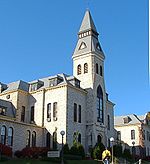
Athletics Big 12 Conference • Kansas State Wildcats • Football • Men's Basketball • Women's Basketball • Baseball • Volleyball • KSU Marching Band • Sunflower Showdown
Facilities: Bill Snyder Family Stadium • Bramlage Coliseum • Ahearn Field House • Tointon Family Stadium • Memorial Stadium • Colbert Hills • Breidenthal Boathouse
People: John Currie • Bill Snyder • Frank Martin • Deb Patterson • Brad Hill • Patrick SweeneyCulture Willie the Wildcat • Aggieville • Beach Museum • Alumni • The Collegian • Royal Purple • Wildcat Victory • Wabash Cannonball • Alma Mater
Broadcasting Miscellaneous Student life Housing: Boyd Hall • Davenport Building • Derby Dining Center • Ford Hall • Goodnow Hall • Haymaker Hall • Jardine Terrace Apartments • Kramer Food Center • Marlatt Hall • Moore Hall • Pittman Building • Putnam Hall • Van Zile Hall • West Hall
Fraternities and sororities:Endowment: $259.8 million • Students: 23,520 • Faculty: 1,242Colleges and universities in Kansas Public institutions Emporia State · Fort Hays State · Kansas · Kansas State · Pittsburg State · Washburn · Wichita State
Private institutions Baker · Barclay · Benedictine · Bethany · Bethel · Brown Mackie · Central Christian · Cleveland Chiropractic · Friends · Hesston · Kansas Wesleyan · Manhattan Christian · McPherson · MidAmerica Nazarene · Newman · Ottawa · St. Mary's · Southwestern · Sterling · Tabor · University of Saint Mary
Community Colleges Allen County CC · Barton County CC · Butler CC · Cloud County CC · Coffeyville CC · Colby CC · Cowley County CC · Dodge City CC · Fort Scott CC · Garden City CC · Highland CC · Hutchinson CC · Independence CC · Johnson County CC · Kansas City Kansas CC · Labette CC · Neosho County CC · Pratt CC · Seward County CC
Technical Colleges Kaw Area Technical School (Now Washburn Institute of Technology) · Wichita Area Technical College · Manhattan Area Technical College · Flint Hills Technical College · Northwest Kansas Technical College · Salina Area Technical College · North Central Kansas Technical College ·
Federal/Military Colleges List of defunct colleges and universities in Kansas Big 12 Conference Current teams Baylor Bears • Iowa State Cyclones • Kansas Jayhawks • Kansas State Wildcats • Missouri Tigers (Leaving in 2012) • Oklahoma Sooners • Oklahoma State Cowboys • Texas Longhorns • Texas A&M Aggies (leaving in 2012) • Texas Tech Red Raiders
Former teams Future teams TCU Horned Frogs (joining in 2012) West Virginia Mountaineers (joining in 2012)
Championships & awards
Coordinates: 39°11′30″N 96°34′51″W / 39.19167°N 96.58083°WCategories:- Kansas State University
- Land-grant universities and colleges
- Association of Public and Land-Grant Universities
- North Central Association of Colleges and Schools
- Public universities
- Education in Riley County, Kansas
- Universities and colleges in Kansas
- Educational institutions established in 1863
- Buildings and structures in Riley County, Kansas
- Visitor attractions in Riley County, Kansas
Wikimedia Foundation. 2010.

